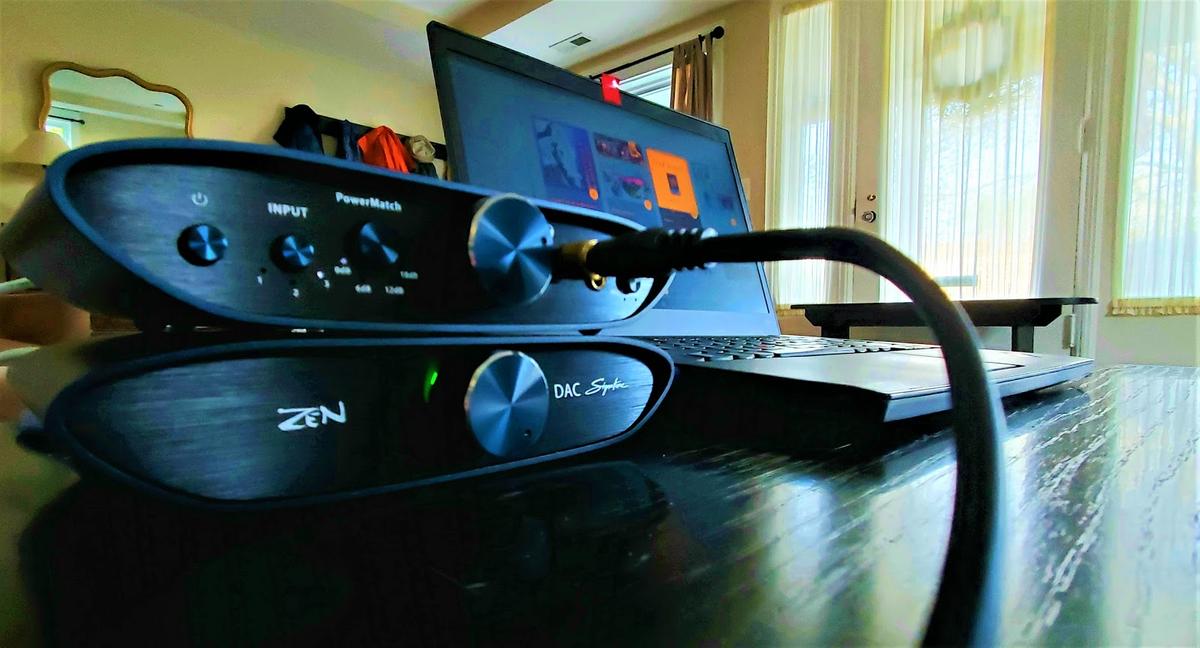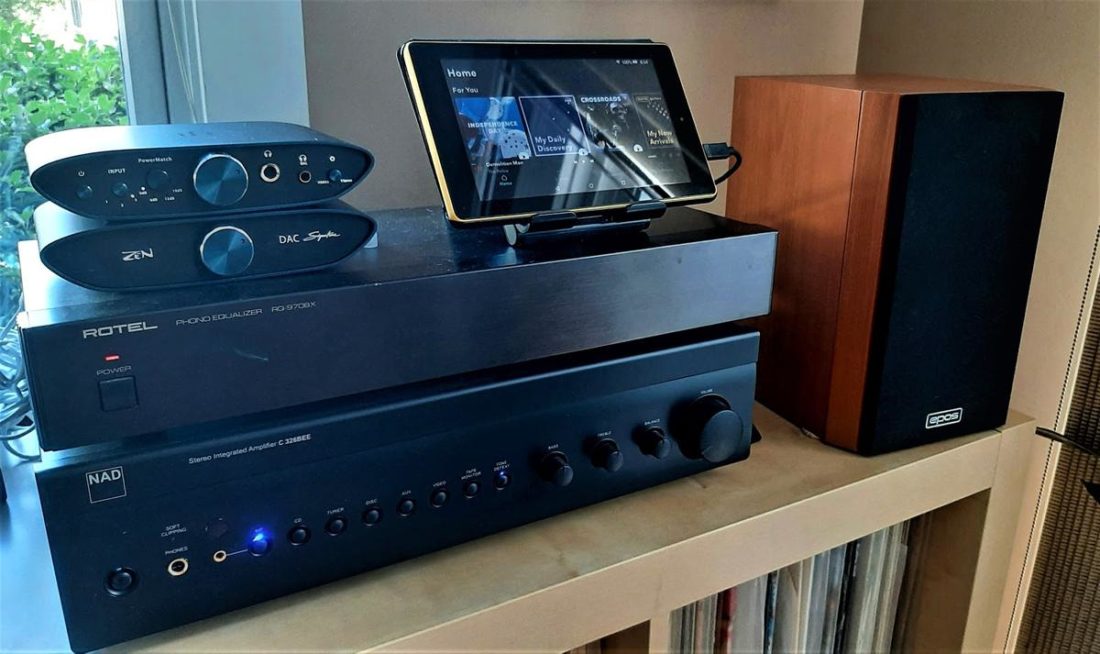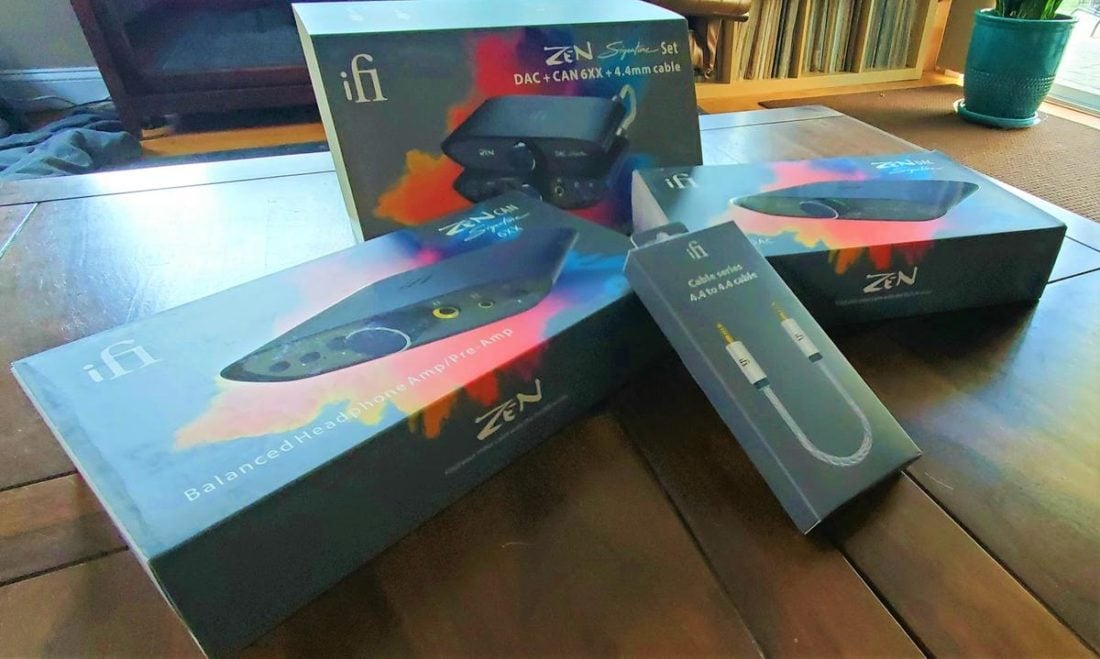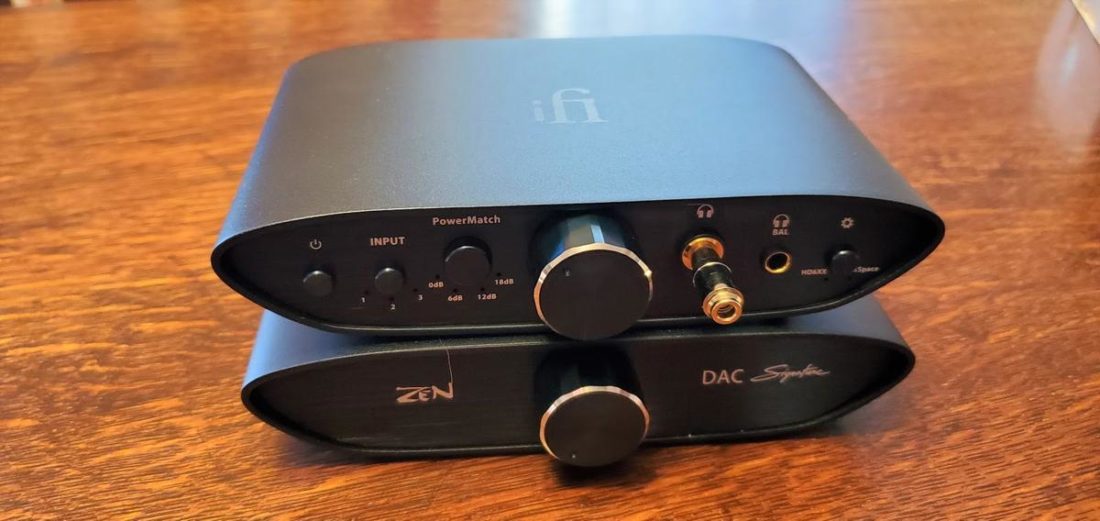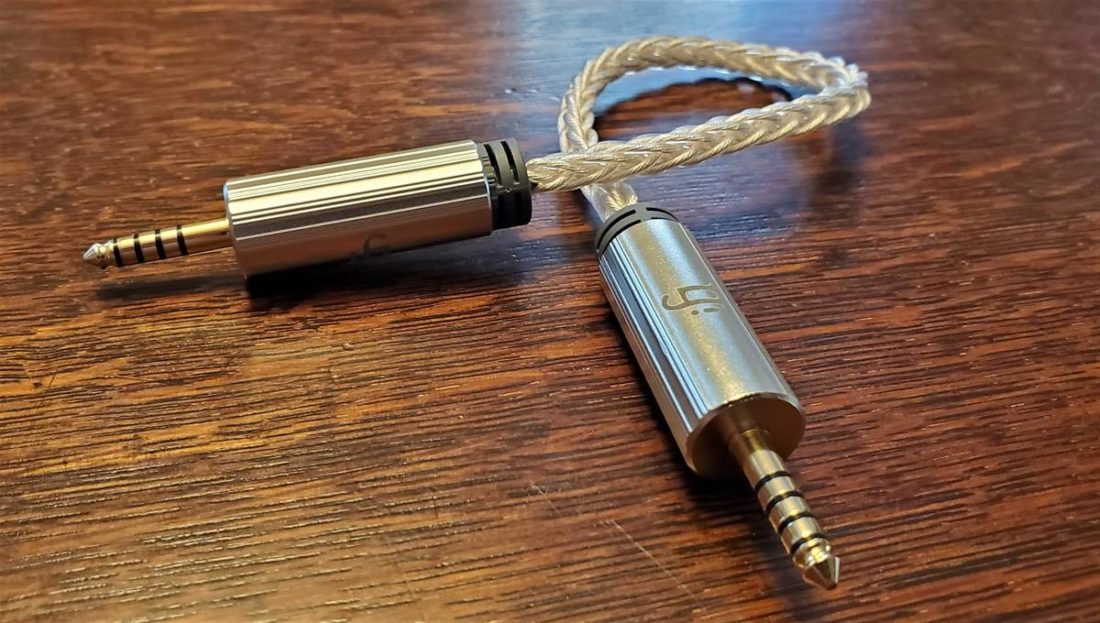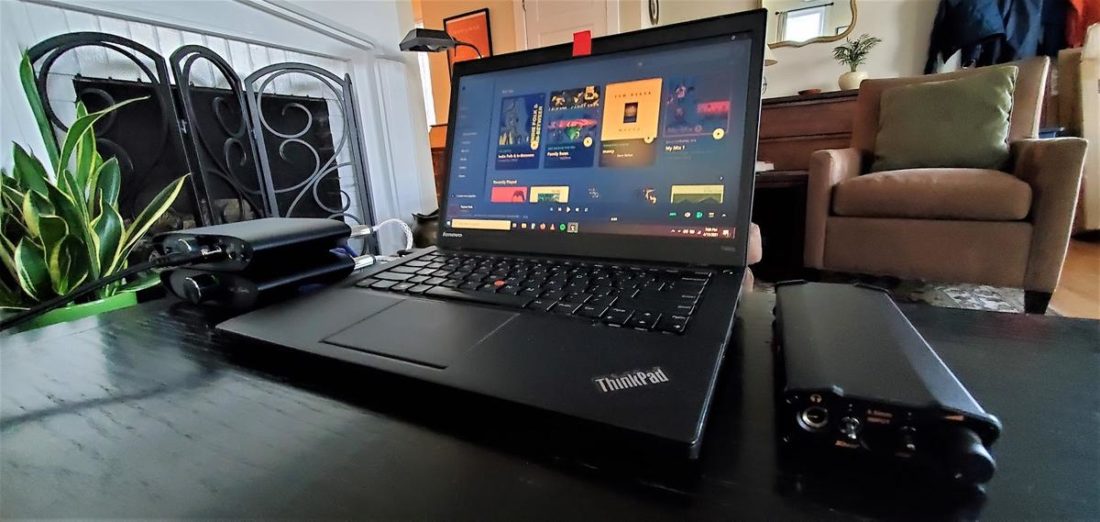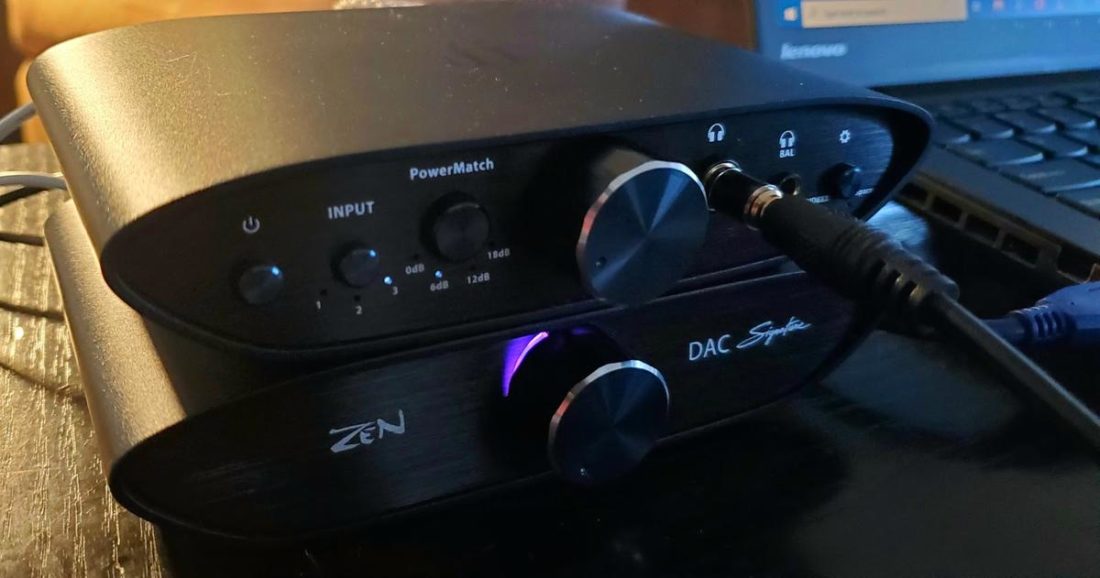I think the hobby of music collecting and listening is, if nothing else, full of moments of deja vu. We listen to our music over and over again and relive lots of moments of our lives to this soundtrack we create. iFi, a very modern audio company, making very modern DAC’s and amplifiers, and Drop has collaborated to release the Zen Signature Set. Though neither is generally in the business of making time machines, they have succeeded wildly in tailoring a pair of devices for their wildly popular HD6xx headphones that look both forward into the HiRes universe, and backward toward the storied past of Audio That Was. As a kid of a working-class New Jersey home in the early 70’s, I grew up in front of the family hi-fi: a gigantic, cherry wood Magnavox console stereo with 15” speakers and a diminutive el84 tube amp living inside it. I was endlessly fascinated with this machine. My mother and I would sit in the living room for hours listening to it with our sad black and white television in the corner sitting largely unused because of this majestic beast. This sonic minotaur of half furniture, half stereo, created my earliest listening memories and filtered through fifty years of listening, I’m positive that my remembrances of it have a much rosier sheen on them than they would if I heard that ancient department store console now. I’m certain it wasn’t built to be a studio piece or a critical listening tool: it was just the era’s response to the need for a decent, inexpensive listening device that fits into the lifestyles of the mid-’60s. But man, what a sound. Time went by, its tubes wore out, its dated looks fell out of favor, and the familial Magnavox was replaced with a much tidier and modish brushed aluminum Kenwood integrated amplifier and a pair of KLH 33’s. The world moved on, and my stereo evolution continued onwards to newer, shinier, more modern things. A whole bevy of other gear came and went – Proton, Rotel, Adcom, B&W, Harman Kardon, Marantz – sexy (or possibly, boring looking) black boxes very much of an era. I’m sure, according to the numbers, things improved, but the huge, enveloping sound of the Magnavox, in particular, stuck with me. Years later, when I was in college, these behemoth consoles started making their way to the curbs of our town. Whether they just wore out or the stereos of the ’90s just made them seem obsolete technology, many of these consoles met their eventual ends on bulk trash days. Being broke and fascinated with them, my friends and I would haul them back to our group houses and work on them. Having listened through the solid-state ’70s, into the more exacting ’80s and ‘90s to the digital era, when we got these working, all of us were transported to a different time, and I think we realized HOW much things had changed. We started looking at the low compliance speakers with low order crossovers and simple amplifiers and began doing the aural math. Parts counts were low. The circuits were simple. And even if they weren’t well made, there was an incredible directness and timbral correctness to the sound from these basic tools. They were flawed beasts, don’t get me wrong, and they were made of the cheapest possible materials that could achieve the job of making music. I think it would be fair to say, all of us taking part in these ‘junk experiments’ took something away from them: that being respect for something well beyond the hyper-buck overbuild fetishization of Krell and Levinson that was going on at the time. The iFi Signature stack, somewhat of a modern technical marvel as a 32 bit DSD capable DAC, paired with a class A balanced amplifier would seem an unlikely comparison to an ancient Magnavox console stereo, but here I am making just that connection. Let me explain.
Technical Specifications
ZEN DAC
Input: USB 3.0 Socket (USB 2.0 Compatible) Formats: 2.8/3.1/5.6/6.2/11.2/12.4 Mhz DSD, 352.8/384 KHz DXD, MQA DAC: Bit-Perfect DSD & DXD DAC by Burr Brown ZOUT: Balanced<=200 Ohm, SE<=100 Ohm SNR: <=117dB (A) @ 0dBFS(BAL/SE) DNR: >117dB (A) @ -60 dBFS (BAL/SE) THD+N: <0.0011% @ 0dBFS(BAL/SE) Outputs: Balanced 4.4mm, 2V-6.2V max. (variable)/4.2v (fixed), RCA (SE) 1V-3.3V max. (variable)/2.1V (fixed) Power consumption: 5v/174ma, P=.887W on idle using included iPower Dimensions: 160(w) x 117(d) x35(h) mm Weight: 0.75kg
ZEN CAN 6XX
Inputs: RCA, 3.5mm (SE), 4.4mm (BAL) Headphone Output: 6.35mm, 4.4mm Gain: 0db, 6db, 12db, 18db adjustable THD+N (A weighting): 0.0066% (BAL), 0.0058% (SE) Output impedance: <2ohms (BAL), <1ohm (SE) Z OUT (BAL line out): 200 ohms SNR: 122 dB (BAL) Dynamic Range: -122 db (BAL) Frequency Response: (-3db): 10Hz to 200 kHz Function Button: HD6xx adaption and/or XSpace; bypass IMD: 0.01% Power Max output power (16 ohms): 3.0V/ 600mW (BAL), 4.0 V/1000mW (SE), Max output power (300 ohms): 5.1V/ 756mW (BAL), 7.6V/196mW (SE), Max output power (600 ohms): 15.2V/ 285mW (BAL), 7.6V/ 98mW (SE) Dimensions: 160(w) x 117(d) x35(h) mm Weight: 0.85kg
Packaging
The packaging of the amp is a lovely affair – nothing too fancy, but much like other iFi products, tidy, organized, simple, and well done. Both device boxes are stacked in a single sleeve, packaged with a box containing a very nice braided Pentaconn interconnect between the two.
In the box
ZEN DAC unit ZEN CAN 6XX unit Two iPowerX power supplies A 4.4mm balanced Pentaconn interconnect One set of RCA cables One 6.5mm to 3.5mm adapter
Design
Tre funky. Some are going to love this design, some aren’t, but at this point, the ZEN aesthetic is a known quantity. The unrepentantly mid-century shape that says ‘amoeba table and Eames chair’ certainly doesn’t hurt my comparison to a mid 60’s console stereo. You aren’t going to lose these devices in a stack of NAD germanic linearity. Add blue anodized brushed aluminum? The chrome-accented knobs? The design team had some fun with this, and I have to admit, I’m pretty fond of the way it looks, if for no other reason than its backward-looking quirkiness jars you out of ignoring the thing. The colors of the Drop team take it one step further. Suffice to say, it’s the only blue audio device I’ve ever held possession of, and I suspect it may stay that way.
Functionality
Functionally, the little ZEN stack is no hugely complex affair, and anyone reading this will have a general sense of what it does. The DAC has a single USB input, an RCA output, and a balanced 4.4mm balanced output. That’s it. There is a volume knob that allows you to use it as a preamplifier for active speakers (if you so desire) or to use it as a pure DAC. It works well in either scenario, and there is precious little to be confused over with additional filters: there are none to manipulate unless you change the firmware. This is very much a set-and-forget proposition. Just the facts, ma’am. The amplifier is similarly uncomplicated, though with a few more configurable options. There are three inputs – RCA, balanced 4.4mm pentaconn, and a 3.5mm single-ended – all switchable via controls on the front. Power Match is a 4 stage preamplifier gain stage providing between 0 and 18db of gain. Functions as it’s written on the tin. I never found it necessary to go above 6db to get enough volume out of the amp, and suspect few would. Volume controls are fully analog, attached to a lovely functioning Alps pot. There is an analog eq control said to be custom tailored for the Drop HD6xx, labeled, perhaps not surprisingly, ‘HD6xx’. And there is the iFi crossfeed circuit labeled ‘XSpace’. Outputs on the front are single-ended 6.5mm, and a 4.4mm balanced Pentaconn jacks, and on the rear, there is a 4.4mm Pentaconn as well.
iFi Zen Signature Set Sound
Since the ZEN Signature set was theoretically engineered for the Drop HD6xx, I started listening with my handy pair after a few days of running music through them. Early impressions were largely that of a relatively neutral sound signature. My only thoughts about the frequency response were that there’s a mild and tasteful mid-lift of a degree that I could easily live with, and that it definitely brought out a good degree of vibrance in most things I listened to. Having done the majority of my leisure listening on iFi devices (an iDSD micro Black Label and iDSD nano Black Label) for the last several years, I was really curious to see how the stack would… er… stack up. Comparatively, my initial response was that it reminded me in ways of the IDSD nano: big and warm, tactile and pretty harmonically juicy. It certainly has much more power than the Nano and has an equivalent amount of power to the Micro in Normal mode. It certainly has much more defined bass than the Nano as well. The DACs sounded vaguely similar – all three being iFi’s Burr-Brown implementation. The family resemblance only goes so far, however. The closest in resemblance is certainly the iDSD micro, which by comparison is a very in-control sound. It’s refined. It’s exact. It’s got depth. In many ways, it seems very English in the same way as a set of Spendor speakers insofar as everything it presents is in a lovely amber glow and eminently listenable. If one were to find fault in it at all, it would be to say that it’s relaxing, but sometimes too relaxing, polished and, well, perfect. Perfect has its place, that’s to be sure, and there are worse complaints to be had. With the ZEN Signature stack, iFi has changed the chemistry a bit, and this is where in sitting down with it, immediately I got transported back to that Magnavox console. My first thoughts were that a similar ‘ragged but right’-ness was cooked in, and clearly, instead of focusing on the ‘perfect’, it seems like John Curl and the iFi team had focused on something a bit looser, more naturalistic, and less polished. The spatial presentation and scale of the Signature seem closer and bigger. The timbres are more vibrant. Dynamically, it has a bit more jump and PRAT. Harmonically and texturally, this amp is different from my other iFis, and it presents more like live music in a small room with all the rasp and bluster in full view. It’s the precocious younger brother for sure. I’m not sure if it’s a matter of the bigger AC power supplies, that the tuning has a bit more upper midrange, maybe it has less global feedback, but it IS a fun presentation with any cans I tried it with. The HD6xx match is great, absolutely, and I felt that the tuning for it is indeed a plus in its small bass lift and tasteful upper-end tweak. This functionality alone will likely sell lots of this amplifier for obvious reasons. But with none of the thoughtful additional tonal circuits engaged, the combination amp and DAC seemed to really have some fantastic synergy with my darker headphones such as the Beyer DT150 or DT250, and especially shone on the Audeze LCD-2C. Brighter cans such as Grado SR80’s, were perfectly usable and sounded great indeed, but were less well matched to my ears for my own particular listening habits. While I am not a big user of IEMs, I did try the balanced connection to a pair of Thieaudio Legacy 5, and found they sounded very respectable with no noticeably higher noise than with my high impedance cans.
Where to Buy
Conclusion
There is, to my mind, a sort of visceral and snotty, forward live-ness going on with the ZEN Set that is very lovable. The at-times wobbly-legged, warts-and-all way it presents things is not, in general, the take of folks looking for ‘pure neutrality’, and likely not for those looking for an overly polished sound. The thing it IS, however, is engaging, big, and enveloping, and full of drive and energy – much like my remembrances of that old console. The spirit of the music is all there. Functionally, there’s very little to be intimidated by, though it offers just enough flexibility, and there is very little chance for any sort of audiophile analysis paralysis to take place. Regardless of whether or not you are using the Drop HD6xx along with it or not, the combo offers a very large helping of musical enjoyment, and it’d be tough not to recommend it to anyone looking for a diminutive and funky (blue) desktop listening solution.
